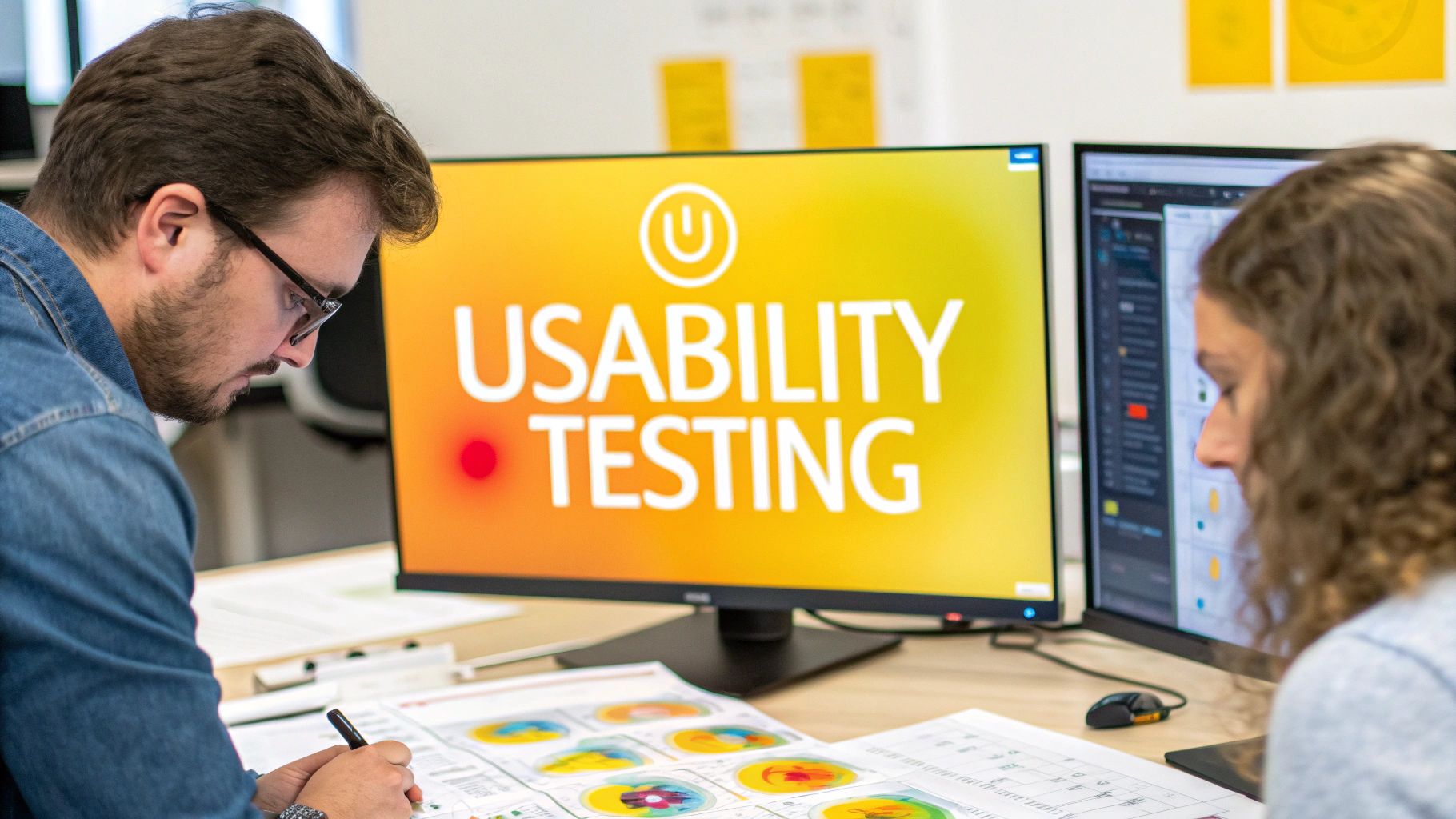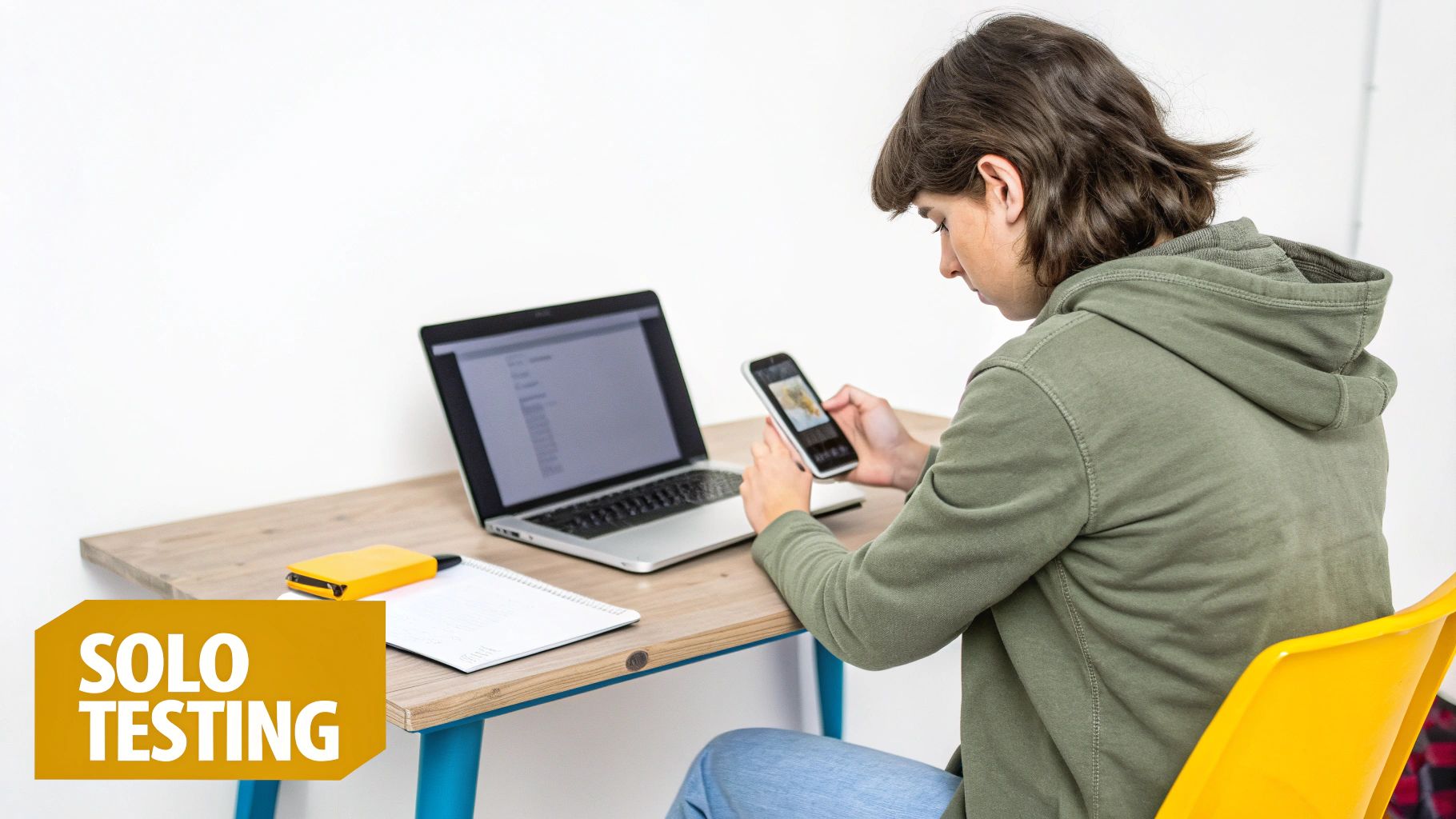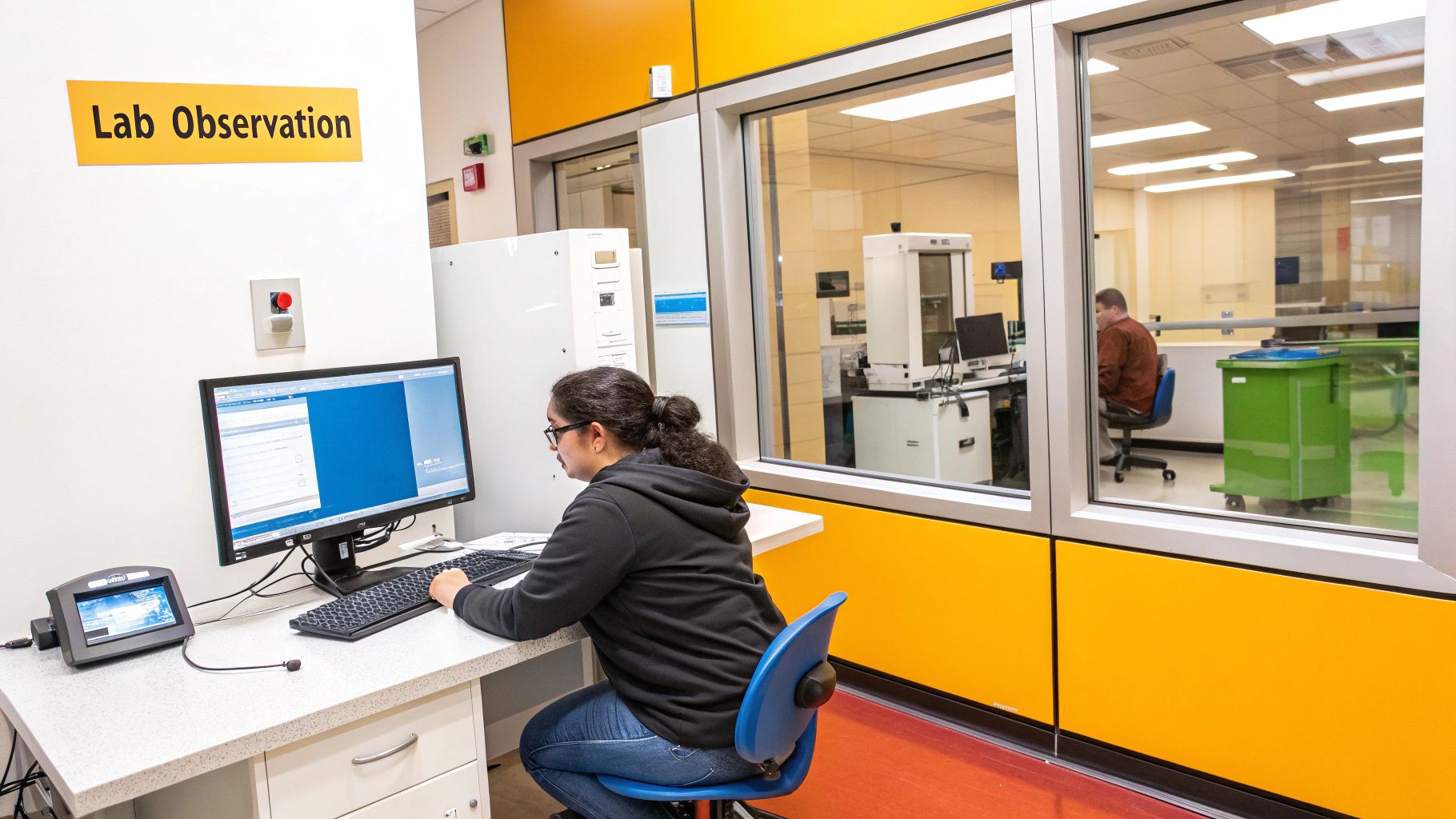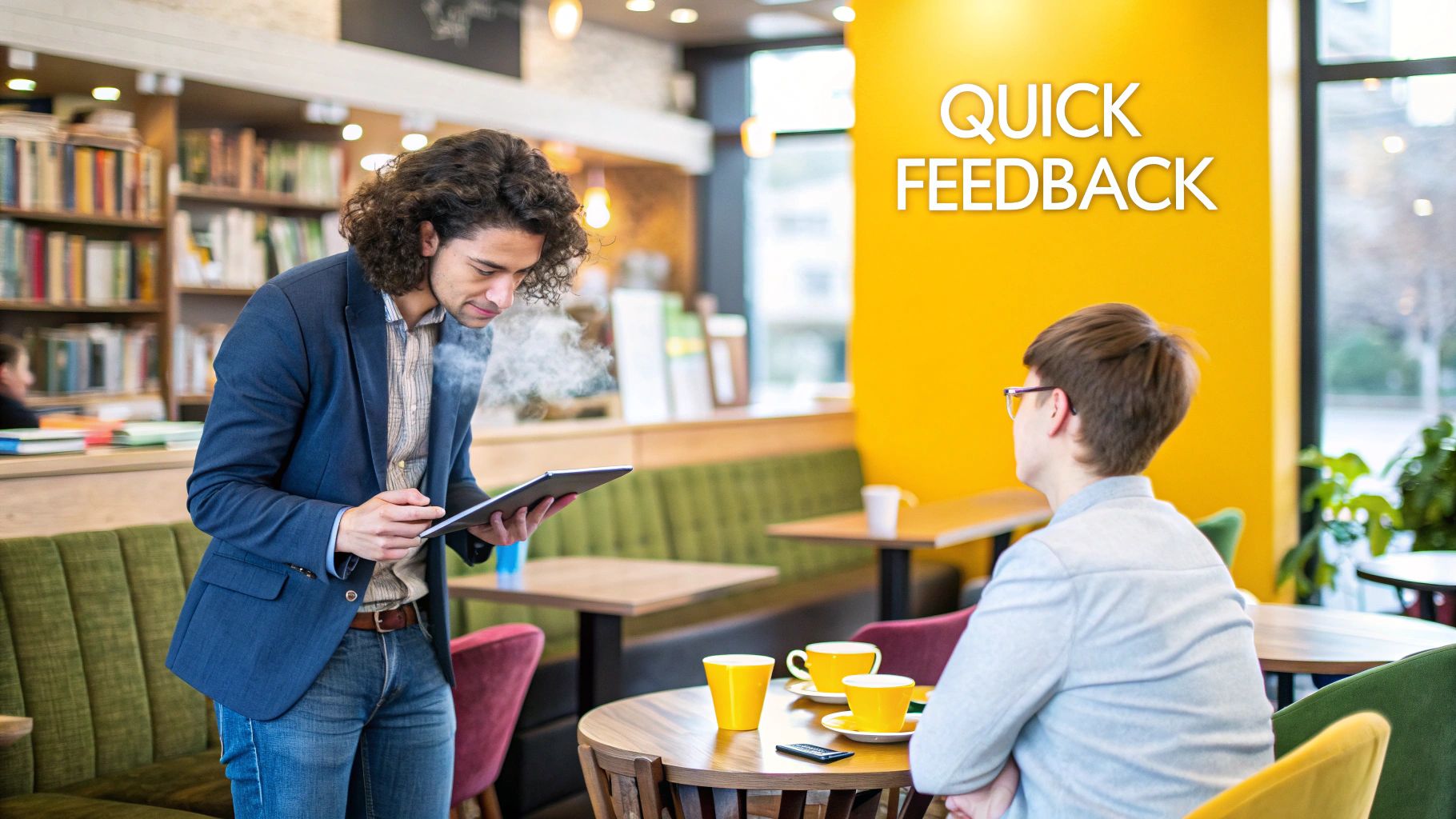7 Essential Usability Testing Methods to Use in 2025

In the world of digital product development, creating an intuitive user experience isn't just a nice-to-have; it's a critical factor for success. But how do you move from assumptions about user behavior to concrete, actionable insights? The answer lies in a structured approach to understanding your users. Guessing what they want or how they'll interact with your product is a surefire way to miss the mark. This is where a robust strategy incorporating various usability testing methods becomes indispensable.
This article serves as your comprehensive guide to the top seven usability testing methods, providing a deep dive into each one. We'll move beyond the basics, equipping you with the knowledge to select the right method for your specific project, budget, and timeline. You'll learn the pros, cons, and practical implementation steps for everything from formal lab studies to quick guerrilla tests. Beyond formal methods, valuable user truths can also be uncovered during real-world exposure, such as when launching a public beta.
By the end of this guide, you will be prepared to stop guessing and start making data-driven decisions that dramatically improve your product's performance and user satisfaction. For any company, from a startup to an established enterprise, mastering these techniques is non-negotiable for building products that truly resonate with their intended audience.
1. Moderated Remote Usability Testing
Moderated remote usability testing is a powerful method where a facilitator guides a participant through a series of tasks in real-time using screen-sharing and video conferencing tools. Unlike in-person tests, participants can complete these tasks from their own home or office, using their own devices. This creates a more natural and comfortable environment, often yielding more authentic user behavior.
The moderator’s role is crucial; they observe the user, ask probing questions, and clarify instructions as needed. This real-time interaction allows for deep qualitative insights and the ability to pivot the session based on unexpected user actions, making it one of the most insightful usability testing methods available today.
When to Use This Method
This approach is ideal when you need to:
- Access a geographically diverse user base. Companies like Airbnb use this to test booking flows with international users who couldn't travel for an in-person study.
- Gather deep, qualitative feedback. The live moderation allows you to ask "why" a user made a certain choice, uncovering motivations and mental models.
- Test complex prototypes or workflows. A moderator can provide assistance if a user gets stuck, ensuring the test can proceed and you still gather valuable feedback on the rest of the flow.
Actionable Tips for Implementation
To ensure a successful moderated remote session, preparation is key.
- Conduct a Pilot Session: Always run a full test with a colleague or internal stakeholder first. This helps you identify any technical glitches, confusing task descriptions, or issues with your script before the real sessions begin.
- Provide Clear Instructions: Send participants a detailed email beforehand explaining the technology they'll need (e.g., Zoom, Google Meet), how to join the session, and what to expect. This minimizes technical delays.
- Establish a Backup Plan: Have a secondary communication method ready, like a phone number, in case the video conferencing tool fails.
- Keep It Concise: Remote sessions can be more draining than in-person ones. Aim for sessions under 60 minutes to combat screen fatigue and maintain participant engagement.
- Record Everything: With participant consent, record the video and audio. This creates an invaluable asset for analysis and for sharing key moments with stakeholders who couldn't attend.
2. Unmoderated Remote Usability Testing
Unmoderated remote usability testing allows participants to complete predefined tasks on their own time, using their own devices and in their natural environment. Specialized software records their screen and audio as they think aloud, but unlike moderated tests, no facilitator is present. This method enables organizations to gather quantitative data and observe user behavior at a much larger scale.

This approach, popularized by platforms like UserZoom and Maze, provides a scalable way to validate designs and measure user performance against benchmarks. Because it removes the moderator's influence, it often reveals more natural, unfiltered user interactions, making it one of the most efficient usability testing methods for collecting behavioral data quickly.
When to Use This Method
This method is most effective when you need to:
- Test with a large, diverse sample size. Netflix uses this approach to test new interface elements with thousands of subscribers, gathering statistically significant data on discoverability and engagement.
- Validate specific, well-defined tasks. Companies like Amazon can use it to optimize a checkout flow by observing how hundreds of users from different demographics complete a purchase.
- Gather feedback quickly and affordably. It’s perfect for fast-paced agile environments where quick turnarounds are needed to inform the next design sprint.
Actionable Tips for Implementation
Success in unmoderated testing hinges on meticulous preparation.
- Write Crystal-Clear Task Instructions: Since no moderator is there to clarify, your tasks must be completely unambiguous. Test instructions on a colleague to ensure they are easy to understand and cannot be misinterpreted.
- Use Robust Screening Questions: Ensure you recruit the right participants by implementing detailed screener questions. This filters out individuals who don't match your target user profile, improving data quality.
- Select the Right Tool: To conduct effective unmoderated remote usability tests, selecting the right recording software is paramount. A comprehensive screen recording software comparison can help you choose a tool with the features you need for capturing high-quality video, audio, and user interactions.
- Mix in Open-Ended Questions: Combine task-based questions with open-ended follow-ups (e.g., "What was the most frustrating part of this experience?") to add qualitative context to your quantitative data.
- Over-Recruit Participants: Plan for a dropout rate of around 20-30%. If you need 50 completed tests, recruit at least 65-70 participants to account for technical issues or incomplete sessions.
3. In-Person Lab Testing
In-person lab testing is a classic usability testing method where a participant interacts with a product or prototype in a controlled, purpose-built environment. Researchers observe the session directly, often from an adjacent room through a one-way mirror, to capture unfiltered behaviors, body language, and verbal feedback without disrupting the user. This method offers unparalleled control over external variables, ensuring that feedback is directly related to the product's design.

Pioneered by institutions like Xerox PARC and popularized by experts like Jakob Nielsen, this approach allows for the use of specialized equipment, such as eye-tracking hardware, to gather precise data. The high-fidelity observation makes it one of the most rigorous usability testing methods for understanding nuanced user-product interactions.
When to Use This Method
This approach is best suited for scenarios where:
- Observing non-verbal cues is critical. For instance, testing a banking ATM interface where a user’s hesitation or physical confusion provides as much insight as their verbal comments.
- Testing requires specialized hardware or software. This is common when testing new physical devices, like Apple does in its secretive labs, or when a specific technical setup is needed that participants don't have at home.
- Confidentiality is paramount. High-stakes projects or unreleased products benefit from the secure, controlled lab environment, preventing leaks or premature exposure.
Actionable Tips for Implementation
To maximize the value of your lab test, focus on creating a controlled yet comfortable setting.
- Create a Naturalistic Environment: Make the lab feel less like a sterile clinic and more like a comfortable office or living room. Provide refreshments, use soft lighting, and ensure seating is comfortable to help participants relax.
- Brief Your Observers: Instruct stakeholders watching the session to remain silent and avoid audible reactions. Gasps or chatter can travel through a one-way mirror and influence the participant's behavior.
- Prepare All Technology: Thoroughly test all recording equipment, software, and hardware before the participant arrives. Have backup devices ready to go to prevent technical failures from derailing a session.
- Plan Buffer Time: Schedule at least 15-30 minutes between sessions. This gives you time to reset the lab, debrief with your team, and welcome the next participant without feeling rushed. A comprehensive software testing checklist on getnerdify.com can help ensure you don't miss a step.
4. Guerrilla Testing
Guerrilla testing is a low-cost, informal method where researchers approach people in public spaces like coffee shops, libraries, or co-working spaces to get quick feedback. Instead of formal recruitment, you find participants on the spot, making it a fast and budget-friendly way to test specific concepts or prototypes. Sessions are typically short, lasting just 5-10 minutes.

The core idea is to gather immediate, real-world reactions to a design or feature without the overhead of a formal lab setting. This "run-and-gun" style of research, popularized by Lean UX practitioners, provides quick directional insights rather than deep, comprehensive data, making it one of the most agile usability testing methods for early-stage validation.
When to Use This Method
This approach is ideal when you need to:
- Get fast feedback on a tight budget. Startups often use this to validate an app concept at a local university campus before investing in development.
- Test a single, specific task or feature. A team could test a new mobile payment flow by asking shoppers in a mall to try it, focusing only on that interaction.
- Validate design directions early in the process. A design agency might test two different website navigation structures in a co-working space to see which one is more intuitive before building it out.
Actionable Tips for Implementation
To maximize the value of your guerrilla sessions, approach them with a clear plan.
- Choose Locations Strategically: Go where your target audience naturally congregates. If you're building an app for fitness enthusiasts, a gym is a better spot than a public library.
- Prepare a Quick Pitch: Have a simple, friendly opening line ready. Something like, "Hi, I'm a researcher working on a new app. Do you have five minutes to give me some quick feedback in exchange for a coffee?"
- Keep Tasks Short and Focused: Design tasks that can be completed in under five minutes. The goal is to get a reaction to a specific element, not test the entire product.
- Bring Small Incentives: A $5 coffee gift card or some branded merchandise can be a powerful motivator for participation. It shows you value their time.
- Follow Up with Formal Testing: Guerrilla testing is great for quick gut checks, but its results are not a substitute for more rigorous, structured testing with carefully recruited participants. Use it to inform, not to finalize.
5. A/B Testing
A/B testing is a quantitative method that compares two or more versions of a single design element by showing different variants to different user groups simultaneously. By measuring which version performs better against specific metrics, such as conversion rates or engagement, teams can make data-driven decisions rather than relying on guesswork. It is one of the most direct usability testing methods for optimizing user actions.
The core principle is scientific control: one group (the control) sees the original design, while another group (the variant) sees the new version. The performance of each is tracked, and the winner is determined based on statistical significance. This approach provides hard numbers to validate design changes, making it invaluable for business-critical interfaces. For more guidance on this, learn more about how to increase website conversions on getnerdify.com.
When to Use This Method
This approach is ideal when you need to:
- Optimize specific conversion points. This method is particularly effective for optimizing landing pages for conversion, helping you understand which headlines, images, or calls-to-action resonate most with users.
- Validate the impact of a minor design change. Companies like Netflix famously test different thumbnail images for shows and movies to see which one drives more clicks and engagement.
- Settle internal debates with data. When stakeholders disagree on a design choice, an A/B test can provide objective evidence to guide the final decision, removing subjectivity from the equation.
Actionable Tips for Implementation
To get meaningful results from your A/B tests, a disciplined approach is essential.
- Test One Variable at a Time: To know what caused a change in performance, isolate a single element. If you change the headline, the button color, and the main image all at once, you won't know which element was responsible for the lift or drop in conversions.
- Ensure Statistical Significance: Don’t end a test prematurely. You need enough traffic and a long enough duration to ensure your results aren't due to random chance. Use a sample size calculator to determine the required audience.
- Define Success Metrics Upfront: Before you launch the test, clearly define what "winning" looks like. Is it a higher click-through rate, more form submissions, or a lower bounce rate? This prevents confirmation bias later.
- Run Tests for Full Cycles: Run tests long enough to account for weekly patterns. User behavior on a Monday morning can be very different from on a Saturday night. A full one or two-week cycle is often recommended.
- Document Everything: Keep a detailed log of every test you run, including your hypothesis, the variants, the duration, and the results. This creates an invaluable knowledge base for future optimization efforts.
6. First-Click Testing
First-click testing is a specialized usability method focused on one critical question: where do users click first to complete a task? The underlying principle is simple yet powerful: if a user’s first click is correct, their chance of successfully completing the task more than doubles. This method provides quantitative data on user intuition and the effectiveness of your information architecture and design cues.
Participants are shown a static image of a webpage or interface and are given a specific task. Their first click is recorded and aggregated into a heatmap, revealing where the majority of users attempt to begin their journey. As one of the most direct usability testing methods for evaluating navigation, it quickly uncovers user confusion and validates design choices before a single line of code is written.
When to Use This Method
This approach is ideal when you need to:
- Validate navigation and information architecture. E-commerce sites use it to see if users click "Men's Apparel" or "Outerwear" when asked to find a winter jacket, optimizing category labels.
- Assess the discoverability of features. A SaaS company can test if users know to click the settings cog or their profile icon to change their password, pinpointing UI clarity issues.
- Test early wireframes and mockups. It's perfect for getting quick feedback on low-fidelity designs, allowing you to iterate on layouts and labels before investing in detailed development.
Actionable Tips for Implementation
To get the most out of first-click testing, precision in your setup is essential.
- Frame Tasks as Scenarios: Don't just ask, "Where would you find billing?" Instead, create a realistic scenario: "You need to download your invoice from last month. Where would you click first?" This elicits more natural behavior.
- Test Both Mobile and Desktop: User clicks can vary dramatically between screen sizes. Always test layouts for different devices to ensure your navigation is effective across the board.
- Include an "I wouldn't click" Option: Sometimes, the right path isn't obvious, and users might feel forced to guess. Allowing them to opt out provides a valuable data point on design confusion.
- Follow Up with Tree Testing: First-click testing shows where users go, while tree testing explains why by validating your site's menu structure. Using them together offers a comprehensive view of your information architecture.
- Record Click Times: Analyze how long it takes users to make their first click. A long delay, even on a correct click, can signal hesitation or a lack of confidence in the design.
7. Card Sorting
Card sorting is a foundational user research method where participants organize topics, features, or content items into categories that make sense to them. This technique provides direct insight into users' mental models, helping designers create intuitive information architectures for websites, applications, and product portfolios. It answers the fundamental question: "Where would users expect to find this information?"
By observing how users group related concepts, teams can design navigation menus, site maps, and content structures that align with user expectations rather than internal organizational charts. This is one of the most effective usability testing methods for building a logical and user-friendly foundation before any design or development begins.
When to Use This Method
This approach is ideal when you need to:
- Design a new information architecture. Before building a new website or app, card sorting helps define the primary navigation and content hierarchy from the ground up.
- Redesign an existing site or feature. If users struggle to find content on your current platform, a card sort can diagnose structural issues and guide a more logical reorganization. For example, a university can use it to restructure how academic programs are presented.
- Validate a proposed structure. A "closed" card sort, where you provide predefined categories, can validate whether your planned architecture resonates with users' expectations.
Actionable Tips for Implementation
To get meaningful results from a card sorting session, a structured approach is crucial.
- Keep Labels Concise: Use clear, simple language for your cards and avoid internal jargon. Each card should represent a single, distinct concept. Aim for 15-60 cards to avoid overwhelming participants.
- Choose the Right Sorting Type: Use an "open" sort (where users create their own category names) for exploratory research. Use a "closed" sort (where you provide the categories) to validate an existing or proposed structure.
- Recruit Representative Users: The insights are only as good as the participants. Ensure the people you recruit accurately represent your target audience for the most relevant results.
- Analyze with Similarity Matrices: Use tools like OptimalSort or spreadsheet analysis to create a similarity matrix. This visually shows which cards were most frequently grouped together, revealing strong patterns in user thinking.
- Follow Up with Tree Testing: Card sorting helps you create a structure, but it doesn't test findability within that structure. Follow up with tree testing to validate if users can successfully navigate your new information architecture to complete key tasks. It's a critical step in the overall UX design process.
Usability Testing Methods Comparison
| Method | Implementation Complexity 🔄 | Resource Requirements ⚡ | Expected Outcomes 📊 | Ideal Use Cases 💡 | Key Advantages ⭐ |
|---|---|---|---|---|---|
| Moderated Remote Usability Testing | Medium - requires moderator and tech setup 🔄 | Moderate - moderator time, stable internet ⚡ | Rich qualitative insights, real-time probing 📊 | Complex tasks, international user research, budget-conscious projects 💡 | Deep understanding of user motivations, flexible scheduling ⭐ |
| Unmoderated Remote Usability Testing | Low - automated setup and task delivery 🔄 | Low - no moderator needed, software based ⚡ | Large-scale quantitative and qualitative data 📊 | Quantitative validation, A/B testing, large feedback collection 💡 | Highly scalable, cost-effective, authentic behavior capture ⭐ |
| In-Person Lab Testing | High - dedicated facilities and equipment 🔄 | High - lab space, professional gear, staff ⚡ | Richest behavioral data including non-verbal cues 📊 | High-stakes launches, complex hardware testing, stakeholder demos 💡 | Maximum control & observation detail, stakeholder buy-in ⭐ |
| Guerrilla Testing | Low - informal, quick setup 🔄 | Very low - minimal equipment, spontaneous ⚡ | Fast, diverse, informal feedback 📊 | Early-stage validation, limited budgets, rapid iteration 💡 | Cost-effective, unbiased participant pool, no scheduling hassle ⭐ |
| A/B Testing | Medium - requires setup of variants and metrics 🔄 | Moderate to high - traffic and analytics ⚡ | Statistically significant, objective results 📊 | Conversion optimization, data-driven decisions, continuous improvement 💡 | Data-driven, scalable, real-world performance measurement ⭐ |
| First-Click Testing | Low - simple task focus and capture 🔄 | Low - basic tools for click tracking ⚡ | Clear visual data on navigation findability 📊 | Navigation design testing, early wireframes, info architecture validation 💡 | Quick, cost-effective, identifies early navigation issues ⭐ |
| Card Sorting | Low to Medium - facilitation or software needed 🔄 | Low - digital or physical cards ⚡ | Insights into user mental models and categorization 📊 | Information architecture design, menu organization, site restructuring 💡 | Directly informs IA, easy for participants, quantitative data ⭐ |
From Insight to Impact: Choosing Your Next Step
Navigating the landscape of usability testing methods can feel like learning a new language. You have explored a diverse toolkit, from the deep, conversational insights of Moderated Remote Testing to the rapid-fire feedback of Guerrilla Testing. We have broken down the large-scale quantitative power of A/B Testing and the foundational architectural guidance provided by Card Sorting and First-Click Testing. The central theme connecting all these approaches is clear: there is no single "best" method. The most effective strategy is always context-dependent, tailored to your specific product, budget, timeline, and research questions.
Your power as a product manager, developer, or startup founder lies not in mastering one technique, but in knowing which to deploy and when. Think of these methods not as isolated options but as interconnected tools in a continuous cycle of improvement. A robust usability strategy is rarely about a single test; it is about building a comprehensive feedback loop that informs your product's evolution.
Synthesizing Your Strategy: From Theory to Action
The true value of understanding these usability testing methods emerges when you start combining them. A sophisticated product development lifecycle might look something like this:
- Foundational Stage: You begin with Card Sorting to understand users' mental models and establish a logical information architecture. This prevents costly structural mistakes down the line.
- Wireframing & Prototyping Stage: Next, you use First-Click Testing on your initial wireframes to validate that the navigation structure you built is intuitive. This confirms users can find what they need without friction.
- Pre-Launch Refinement: As the UI becomes more detailed, you conduct Moderated Remote Sessions with a small, targeted group. This allows you to dig deep into complex workflows, uncover subtle pain points, and gather rich qualitative feedback to refine the user experience.
- Launch & Optimization: Once the product is live, you deploy A/B Testing to optimize critical conversion points like sign-up forms or checkout flows. You might also run Unmoderated Remote Tests with a larger audience to gather quantitative data on task success rates and identify broader usability trends.
The Ultimate Goal: A Culture of User-Centricity
Integrating these usability testing methods into your workflow does more than just fix broken features; it transforms your organization's culture. It shifts the focus from "we think" to "our users show us." This user-centric approach de-risks development, reduces wasted engineering hours, and builds products that don't just function but delight. By consistently listening to and observing your users, you turn feedback from a reactive measure into a proactive engine for innovation and market leadership. The journey from a good idea to a great product is paved with user insights. Your next step is to choose the right tool and start listening.